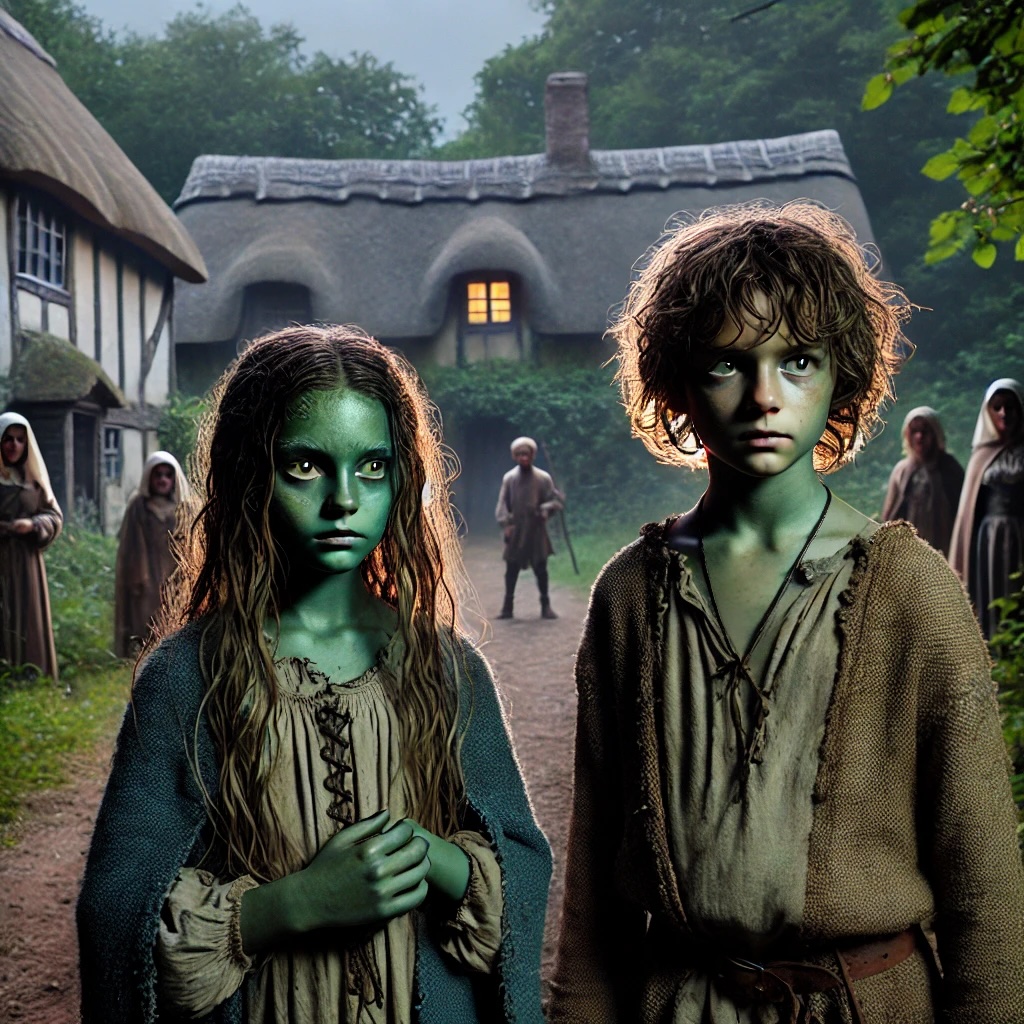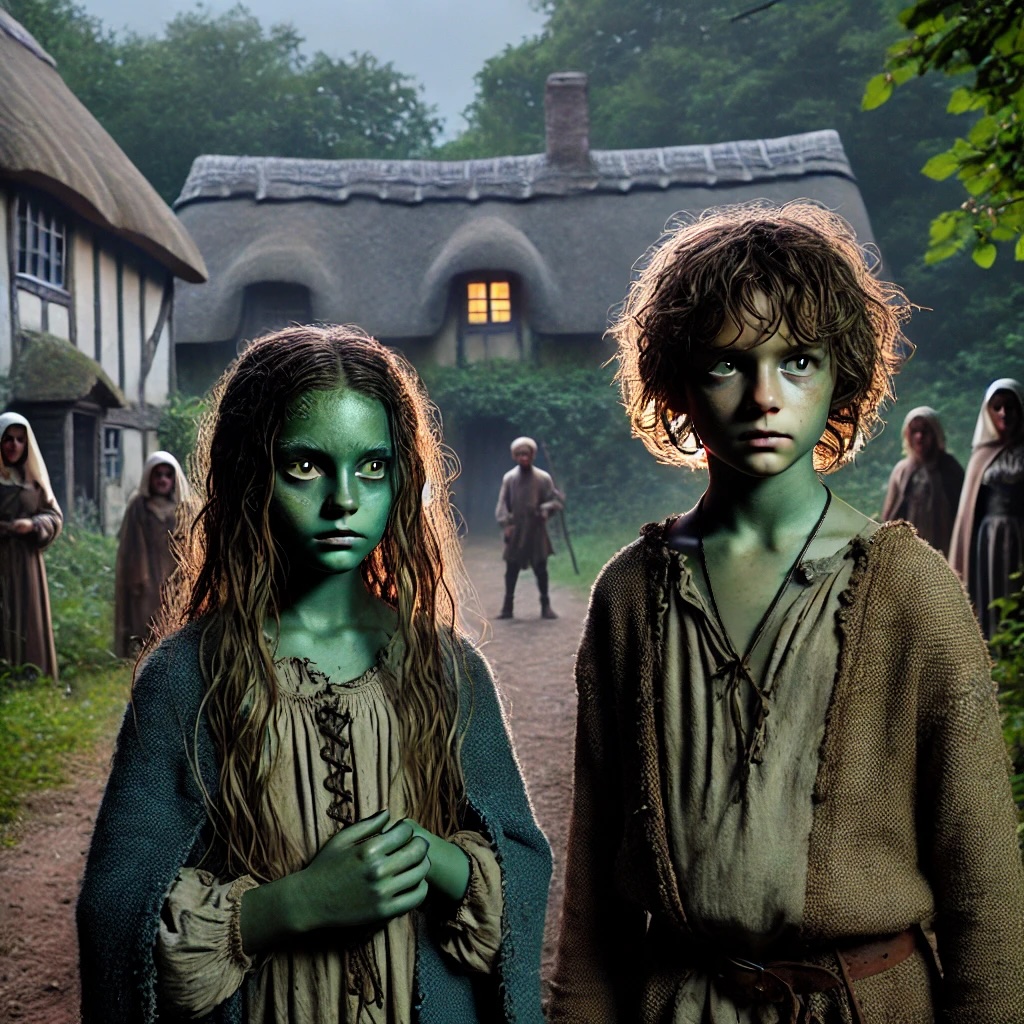Why be normal, when the weird stuff is way more interesting?
In the 12th century, a strange and captivating story emerged from the small English village of Woolpit in Suffolk. Two children, a boy and a girl, were found near the village. They were unlike any children the villagers had ever seen—their skin was green, their clothing was made of an unfamiliar material, and they spoke a language no one could understand. Over the years, this tale has sparked countless theories and debates. Were they refugees from a hidden civilization? Visitors from another dimension? Or something even more extraordinary?
Discovery of the Green Children
The story begins during the reign of King Stephen (1135–1154), when agricultural workers stumbled upon the two children near a wolf pit (from which Woolpit derives its name). The children appeared frightened and confused, and their most striking feature was their green-hued skin. They were taken to the home of Sir Richard de Calne, a local landowner, where their strange saga unfolded.
The Children’s Behavior and Adaptation
Initially, the children refused to eat any of the food offered to them. Days passed before they finally accepted raw broad beans, which they ate ravenously. Over time, they began to adapt to their new environment and eventually started eating a broader range of foods. As their diet changed, the green tint of their skin gradually faded.
The children’s language posed another mystery. No one in Woolpit or the surrounding areas could understand their speech. Slowly, they began to learn English, and once they could communicate, their story took an even stranger turn.
The Children’s Origins
When questioned about their origins, the children claimed to have come from a place called “St. Martin’s Land,” a subterranean world where the sun never shone, and everything was bathed in a perpetual twilight. They described their home as a place where all the inhabitants were green like them and said they had been tending their family’s livestock when they heard a loud noise and suddenly found themselves in Woolpit.
The boy, unfortunately, did not survive long after their discovery. He succumbed to an illness soon after arriving in Woolpit. The girl, however, grew up and integrated into English society. She was baptized and later married a man from King’s Lynn, Norfolk. Accounts suggest she lived a relatively normal life but retained her unusual origins.
Possible Explanations
The Green Children of Woolpit have baffled historians, scientists, and folklorists for centuries. Numerous theories have been proposed to explain their peculiar story:
1. Hidden Refugees
Some believe the children were Flemish refugees. During the 12th century, many Flemish settlers were persecuted in England. The children’s unfamiliar clothing and language might have been Flemish, which would have seemed alien to the villagers of Woolpit. Their green skin could be attributed to chlorosis, a form of anemia caused by malnutrition.
2. A Folktale with Symbolic Meaning
Another theory suggests that the story is a folk tale with allegorical elements. The green skin could symbolize youth or otherness, while the children’s journey to Woolpit could represent a Christian allegory of conversion and salvation.
3. Interdimensional Beings
For those who enjoy more speculative theories, the children’s description of St. Martin’s Land—a twilight world—has led to suggestions that they were interdimensional travelers. The idea of parallel worlds has gained traction in modern science, and some enthusiasts argue that the children’s tale aligns with such concepts.
4. Extraterrestrial Visitors
The theory that garners the most intrigue is that the children were extraterrestrial beings. Advocates of this idea point to their green skin, unfamiliar language, and otherworldly origins as evidence of an alien connection. Could they have been stranded on Earth due to a malfunctioning spacecraft?
Historical Context
The 12th century was a time rife with superstition and mystery. Stories like the Green Children of Woolpit were not uncommon, often serving as explanations for events or phenomena that defied understanding. However, the specificity and detail of this account have allowed it to endure for centuries.
One key source for the tale is the chronicler Ralph of Coggeshall, who recorded the story in his work Chronicon Anglicanum. Another version was documented by William of Newburgh in Historia Rerum Anglicarum. These accounts differ slightly but agree on the core details, lending the story a semblance of credibility.
Legacy of the Green Children
The tale of the Green Children has left a lasting mark on Woolpit, with the village embracing its mysterious past. Visitors can explore landmarks like St. Mary’s Church, which dates back to the era of the children’s arrival, and learn about the legend through local folklore.
The story also continues to inspire writers, artists, and filmmakers. It has been reimagined in novels, plays, and even modern speculative fiction, ensuring that the mystery of the Green Children endures.
A Mystery for the Ages
The Green Children of Woolpit remain an enigma. Whether they were malnourished refugees, travelers from another dimension, or extraterrestrial visitors, their story captures the imagination and invites us to ponder the unknown. In an age when science and reason often dominate our understanding of the world, tales like this remind us that some mysteries may never be fully explained. And perhaps that’s part of their enduring appeal.


